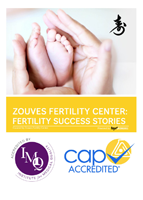
Proud member of the Zouves Fertility Center family.
For almost 30 years, embryos have been transferred fresh, in the same cycle in which a woman is stimulated with fertility medications and undergoes egg retrieval. We have learned this is not an optimal situation to transfer when high levels of estrogen and enlarged tender ovaries challenge the body. We now know that a natural ovulatory cycle yields the best outcome for the baby and also for the pregnant mother.
Frozen/thawed embryos were previously less vital and the rate of loss was almost 30%. As a result of this decrease in vitality when embryos were frozen in the past, the trade-off was to do the fresh transfer even though the uterus was not optimally receptive.
This all changed with the introduction of the rapid freeze called vitrification.
Vitrification and Cryopreservation
Perfected in Japan by Dr. Masashige Kuwayama (2000) of the Kato Ladies Clinic, vitrification is the rapid cryopreservation of eggs or embryos. Vitrification literally translates as “changing into glass” and differs significantly from slow cooling methodologies of the past. Eggs are frozen so quickly that the egg is instantly changed into a chemical glass that is maintained at ultra low temperatures.
With the introduction of vitrification, the survival rates for both eggs and embryos has risen to over 95% and the resulting gametes appear to be almost as good as they were in the fresh state. This single innovation allows us to consider the option of banking either eggs or embryos without compromising success when these gametes are ultimately used.
In the IVF Laboratory at Zouves Fertility Center, frozen embryo transfer procedures now yield the same or even better success rates compared with the transfer of fresh embryos when the egg provider has herself been stimulated and undergone egg retrieval.
The Success Rate of IVF Delayed Transfer
As the success rate with frozen/thawed embryos approaches and surpasses the pregnancy rate in fresh cycles, more and more cycles of conventional IVF are now becoming cycles where embryos are being banked by vitrification. In this process, the patient returns with the following ovulation for a frozen transfer either with their natural cycle or in a controlled transfer setting. This allows for all of the negative effects of the fertility stimulation drugs to leave the body.
Experts from Aberdeen University reviewed 11 previous studies, which followed more than 37,000 pregnancies to birth resulting from the transfer of either fresh or frozen thawed embryos. When frozen embryos were used, there was a 30% lower risk of bleeding during pregnancy, 30-40% less chance of the baby being born underweight, 20% lower chance of premature delivery and 20% less likelihood of dying in the neonatal period. The study found that pregnancies arising from the transfer of frozen thawed embryos had better outcomes for mothers and babies than those using fresh embryos. Dr. Maheshwari, the author of the study, concluded “if pregnancy rates are equal and outcomes in pregnancies are better, our results question whether one should consider freezing all embryos and transfer them at a later date, rather than transferring fresh embryos.”
At Zouves Fertility Center, we have been monitoring our pregnancy rates in fresh and frozen transfers and have noticed a steady increase in the success rates in the frozen transfers since 2009. In early 2012, frozen embryo success rates surpassed fresh pregnancy rates. This is due to the benefits of vitrification, which we perform with all gametes in our program.
Options for Embryo Transfer
Options for transferring frozen embryos back to the uterus:
- Natural
This occurs when a patient tracks her ovulation. Once the LH surge has been identified and confirmed, the embryos are transferred approximately one week later. - Controlled
This method does not rely on natural ovulation and in fact natural ovulation is suppressed. Estrogen and progesterone are added in sequence to prepare the uterine lining. This method is more suitable when patients live far away from the Center or for patients where the ovulation is unpredictable.






